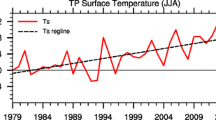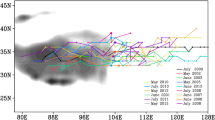Summary
In this paper, the thermal features of the atmosphere over the Tibetan Plateau in summer and their effects on the general circulation are reviewed. Some recent research results are reported. It is shown that the Plateau acts as a heat source in summer. Particularly the strong surface heating makes the air stratification very unstable and produces strong near-surface convergence and positive vorticity and upper layer divergence and negative vorticity. Intense convective activity generated thereby not only maintains such particular large-scale circulation pattern over the Plateau, but also transports large amounts of sensible heat, moisture, chemical pollutants, as well as air with low ozone concentration from near-surface layers to upper layers. A minimum centre of total ozone concentiation and a huge upper layer anticyclone with a warm and moist core are thus observed over the Plateau in summer. The strong divergent flow and anticyclonic vorticity source in the upper atmosphere have a strong influence on the general circulation over the world via meridional as well as longitudinal circulations, and energy, dispersion on a spherical surface. It is shown that the surface sensiole heating of the Plateau is essential for the occurrence of the abrupt seasonal change of the general circulation there, and for the persisten maintenance of the Asian monsoon. It is also reported that the elevated heating of the Tibetan Plateau together with its mechanical forcing cause the early onset of the Asian monsson to happen over the eastern coast of the Bay of Bengal, which then generates a favorable circulation background for the monsoon onset over the South China Sea. The Indian monsoon onset flows aftervards.
Similar content being viewed by others
References
Bolin, B., 1950: On the influence of the earth's orography on the westerlies.Tellus,2, 184–195.
Chandresekhar, S., 1961:Hydrodynamic and Hydromagnetic Stability. Oxford, England: Oxford at Clarendon Press.
Chang, C. P., Chen, G. T. J., 1995: Tropical circulation associated with southwest monsoon onset and westerly surges over the Southern China Sea.Mon. Wea. Rev. 123, 3254–3267.
Charney, J. G., Eliassen, A., 1949: A numerical method for predicting the perturbations of the middle latitude westerlies.Tellus.1, 38–54.
Chen, Longxun, Gong, Z. B., Chen, C. B., Ren, C. J., 1965: The atmospheric radiation budget over Asia (3).Acta Meteorologica Sinica,35, 6–17.
Cressman, G. P., 1960: Improved terrain effects in barotropic forecasts.Mon. Wea. Rev.,88, 327–342.
Fiedler, F., Panofsky, H. A., 1972: The geostrophic drag coefficient and the Effective Roughness Length.Quart. J. Roy. Meteor. Soc.,98, 213–220.
Flohn, H., 1957: Large-scale aspects of the “summer monsoon” in South and East Asia.J. Meteor. Soc. Japan (75th Ann. vol.), 180–186.
Flohn, H., 1968: Contributions to a meteorology of the Tibetan Highland, Atmos. Sci. Paper, No. 130, Colorado State Uni., Ft. Collins.
Hahn, D. G., Manabe, S., 1975: The role of mountain in the south Asia monsoon.J. Atmos. Sci.,32, 1515–1541.
Holton, J. R., Colton, D. E., 1972: A diagnostic study of the vorticity balance at 200 hPa in the tropics during Northern summer.J. Atmos. Sci.,29, 1124–1128.
Koo, C. C., Yeh, T. C., 1955: Some calculations of the influence of the large-scale topography on the climate of China.Acta Meteor. Sinica,26, 167–182, in Chinese.
Krishnamurti, T. N., 1971. Tropical east-west circulation during the Northern Summer.J. Atmos. Sci.,28, 1342–1347.
Li, C. F., Yanai, M., 1996: The onset and internnual variability of the Asian summer monsoon in relation to land-sea thermal contrast.J. Climate,9, 359–375.
Luo, H., Yanai, M., 1984: The large-scale circulation and heat sources over the Tibetan Plateau and surrounding areas during early summer of 1979, Part II: Heat and Moisture budgets.Mon. Wea. Rev.,112, 966–989.
Murakami, T., 1987: Effects of the Tibetan Plateau.Monsoon Meteorology. Change C.-P., Krishnamurti, T. N. (Eds.) New York, Oxford: Oxford University Press, pp. 235–270.
Nitta, T., 1983: Observational study of heat sources over the eastern Tibetan Plateau during summer monsoon.J. Meteor. Soc. Japan,61, 590–605.
Qian, Zheng' an, Zhang, Shimin, Shan, Fumin, 1984: Analysis of the convective clouds over the plateau in summer, 1979: Collected papers of the Qinghai-Xizang Plateau Meteorological Science Experiment, Vol. I, Science Press (in Chinese).
Reiter, E. R., Tang, M. C., 1984: Plateau effects on diurnal circulation pattens.Mon. Wea. Rev.,112 (4), 638–651.
Reiter, E. R., 1982: Thermal effects of the Tibetan Plateau on atmospheric circulation systems, Proceedings of the First Sino-American Workshop on Mountain Meteorology, Beijing, May 18–23, 1982, Science Press.
Research Group of Experimental Simulation, 1977: An experimental simulation on the three-dimensional structure of the airflow field over the Qinghai-Tibetan plateau in summer.Scientia Atmospherica Sinica,1, 247–255.
Research Group on Experimental Simulation, 1978: The annulus simulation of the summer large-scale convective systems over Qinghai-Tibetan Plateau.Scientia Sinica,21, 347–364.
Rodwell, M. J., Hoskins, B. J., 1996: Monsoon and the dynamics of deserts.Quart, J. Roy. Meteor. Soc.,122, 1385–1404.
Sardeshmukh, P. D., Held, I. M., 1984: The vorticity balance in the tropical upper atmosphere of a general circulation model.J. Atmos. Sci.,41, 768–778.
Sardeshmukh, P. D., Hoskins, B. J., 1985: Vorticity balance in the tropics during the 1982–83 El Nino-Southern Oscillation event.Quart. J. Roy. Meteor. Soc.,111, 261–278.
Smagorinsky, J., 1953: The dynamical influence of largescale heat sources and sinks on the quasi-stationay mean motion of the atmosphere.Quart. J. Roy. Meteor. Soc.,79, 342–366.
Song, Zhenshan, Zhu, Baozhen, Sun, Guowu, 1984: A preliminary study on the mixed layer over the western plateau, Collected papers of the Qinghai-Xiznag Plateau Meteorolgical Science Experiment, Vol. II, Science Press. (in Chinese).
Tang, Maocang, 1979:The Pressure and Wind, Chaper 3: Meteorology of Tibetan Plateau, Beijing: Sclence Press. (in Chinese).
Wu. Guoxiong, Zhu, Baozheng, Gao, Dengyi, 1996: The impact of Tibetan Plateau on local and regional climate, From Atmospheric Circulation to Global Change, Ed. by Institute of Atmospheric Physics, CAS, China Meteor. Press, 425–440.
Wu, Guoxiong, Li, Weiping, Guo, Hua, Liu, Hui, 1997a: Sensible heat-driving air pump of the Tibetan Plateau and the Asian summer monsoon. Momorial Volume of Prof. Zhao Jiuzhang. Ye Da-Zheng (Eds.), Beijing, Chinese Science Press, 116–126. (in Chinese).
Wu, Guoxiong, Zhang Xuehong, Liu, Hui, Yu Yongqiang, Jin Xianzhe, Guo Yefu, Sun Shufeng, Li, Weiping, 1977b: The LASG global ocean-atmosphere-land system model (GOALS/LASG) and the associated simulation study,J. Appl. Meteor.,8 (Special Issue), 15–23. In Chinese.
Wu, Guoxiong, Zhang, Yongshen, 1998: Tibetan Plateau forcing and monsoon onset over South Asia and South China Sea.Mon Wea. Rev.,126 (4), 913–927.
Yanai, M., Li, C. F., Song, Z. S., 1992: Seasonal heating of the Tibetan Plateau and its effects on the evolution of the Asian summer monsoon.J. Meteor. Soc, Japan,70, 319–351.
Yang, Jianchu, Tao, Shiyan, Gu, Zhenchao, Ye, Duzheng, 1960:Meteorology of Tibetan Plateau, Beijing: Science Press, (in Chinese).
Yang, Weiyu, Ye, Duzheng, Wu, Guoxiong, 1990: Some aspects of the Qinghai-Xizang Plateau meteorology.Scientia Sinica (B),10, 1100–1111.
Yang, Weiyu, Ye, Duzheng, Wu, Guoxiong, 1992a: The influence of the Tibetan Plateau on the thermal and circulation fields over East Asia in summer. I. Humidity over the western Tibetan Plateau.Chinese J. Atmos. Sci.,16, 41–51.
Yang, Weiyu, Ye, Duzheng, Wu, Guoxiong, 1992b: the influence of the Tibetan Plateau on the thermal and circulation fields over East Asia in summer. II. Main features of the local and large-scale vertical circulation fields.Chinese J. Atmos. Sci.,16, 287–301.
Yang, Weiyu, Ye, Duzheng, Wu, Guoxiong, 1992c: The influence of the Tibetan Plateau on the thermal and circulation fields over East Asia in summer. III. Physical mechanism of maintaining the stable circulation field.Chinese J. Atmos. Sci.,16, 409–426.
Ye, Duzheng (Yeh, T. C.), Tao, Shiyang, Li, Maicun, 1959: The abrupt change of circulation over the Northern hemisphere in June and October. Bolin, B. (ed.)The Atmosphere and the Sea in Motion. Scientific Contributions to the Rossby Memorial Volume, The Rokce Seller Institute Press and Oxford University Press, 249–267.
Ye, Duzheng, Change, C. C., 1974: A preliminary experimental simulation of the heating effect of the Tibetan Plateau on the general circulation over East Asia in the summer.Scientia Sinica,12, 397–420.
Ye, Duzheng, Yang, Guangji, 1979:The average vertical circulation over the Qinghai-Xizang Plateau. Beijing. Science Press, (in Chinese).
Ye, Duzheng, 1982: Some aspects of the thermal influences of the Qinghai-Tibetan Plateau on the atmospheric circulation.Arch. Meteor. Geophys. Bioclim, Series A,31, (1), 205–220.
Ye, Duzheng, Gao Youxi, et al., 1979:Meteorology of the Qinghai-Xizang Plateau, Chapter 1. Beijing: Science Press.
Ye, Duzheng, Li, Jishun, Gao, Dengyi, 1974: The maintenance of large-scale mean summer circulation over the Qinghai-Xizang Plateau by convective activities. Collected Papers of the Qinghai-Xizang Plateau Meteorology, 19–28. (in Chinese).
Ye, Duzheng, Yang, Guangji, Wang, Xingdong, 1979: The average vertical circulation over East Asia and the Pacific area, part I: in summer.Scientia Atmospherical Scinica,3, 1–11. (in Chinese).
Ye, Duzheng, Gao, Dengyi, 1979: The influence on the atmosphere of the heating of Mount Qomolangma during spring and summer. Report of Science Expedition on Mount Qomolangma (1975). Meteorology and Environment, Chinese Science Press.
Ye, Duzheng, 1993:Thermodynamic Structure Convective Activities and Associated Large-Scale Circulation over Tibetan Plateau in Summer. Frontiers in Atmospheric Sciences, New York: Allerton Press Inc., 1–17.
Yeh, T. C., 1950: The circulation of the high troposphere over China in the winter of 1945–1946.Tellus,2, 173–183.
Yeh, T. C., Lo, S. W., Chu, P. C., 1957: On the heat balance and circulation structure in the troposphere over the Tibetan Plateau and this vicinity.Acta Meteor. Sinica,28, 108–121 (in Chinese).
Yin, M. T., 1949: a synoptic-aerologic study of the summer monsoon over India and Burma.J. Meteor.,6, 393–400.
Yuan, Fumao, 1979:The Climate Features of the Weather Phenomena of the Qinghai-Tibetan Plateau and its Neighborhood, Chapter 7: Meteorology of the Qinghai-Tibetan Plateau, Beijing, Science Press, (in Chinese).
Zeng, Qingcun, Laang, Xingzhong, Zhang, Minghua, 1988: Numerical modelling on monsoon and the abrupt seasonal change of the general circulation of the atmosphere,Chinese J. Atmos. Sci., (Special Issue), 22–42, in Chinese.
Zeng, Qunzu, Guan, Youguang, 1975:The heat Balance over Rongbu Glacier during Melting. Report of Science Expedition on Mount Qomolangma (1966–1968). Modern Glacier and Topography, Chinese Science Press.
Zhang, Jijia, Zhu, Baozhen, Zhu, Fukang, Weng, Duming, Sun, Guowu, Lu, Junning, Peng, Youngqing, Wang, Yuanzhong, 1988:Advances in the Qinghai-Xizang Plaicau Meteorology — The Qinghai-Xizang Plateau Meteorological Experiment (1979) and Research. Beijing: Science Press, 268 pp. (in Chinese).
Zhou, Xiuji, Luo, Chao, Li, Weiliang, Shi, Jiueng, 1995: Variation of the total ozone concentration over China and the minimum center over the Tibetan Plateau.Chinese Sci. Bull.,40, 1396–1398.
Zuo, Dakang, (Tso, T. K.), 1963: The distribution of net radiation of the earth's surface in China. Symposium of Insitute of Geography.Academia Sinica (Climatology),6, 126–146.
Author information
Authors and Affiliations
Additional information
With 13 Figures
While I visited USA in the summer of this year (97) the sad news of the death of Professor Riehl came to me. This was a great shock to me. Herb was my esteemed colleague and friend. During the later half of my stay at the University of Chicago in the 40s I spent most of the time with Herb and worked with him. Every weak we have several discussion through which I learnt a lot from him. I cannot forget our discussions in one morning. This discussion helped me to formulate a paper “The circulation of the high troposphere over China in the winter of 1945–1946” which was published in Tellus (1950). This paper demonstrated for the first time the existence of a strong jet stream around the southern periphery of Tibetan Plateau. This jet stream is usually called southern jet stream in China, because there is also a northern one to the north of the Tibetan Plateau, These two jet streams merge into one downstream of the plateau forming the stronges jet stream in the northern hemisphere. This Tellus paper and a paper by Bolin, which also appeared in Tellus (1950), stimulated my interest in studying the role of the Tibetan Plateau in the general circulation for several decades. Because of Herb's stimulation, a colleague of mine and I write this review article in the volume in memorizing Herb's big contribution to meteorology.
Because of the adoption of Pinyin in the 1960s, Yeh T. C. became Ye D.-Z
Rights and permissions
About this article
Cite this article
Ye, DZ., Wu, GX. The role of the heat source of the Tibetan Plateau in the general circulation. Meteorl. Atmos. Phys. 67, 181–198 (1998). https://doi.org/10.1007/BF01277509
Received:
Revised:
Issue Date:
DOI: https://doi.org/10.1007/BF01277509




